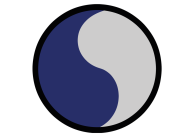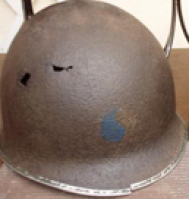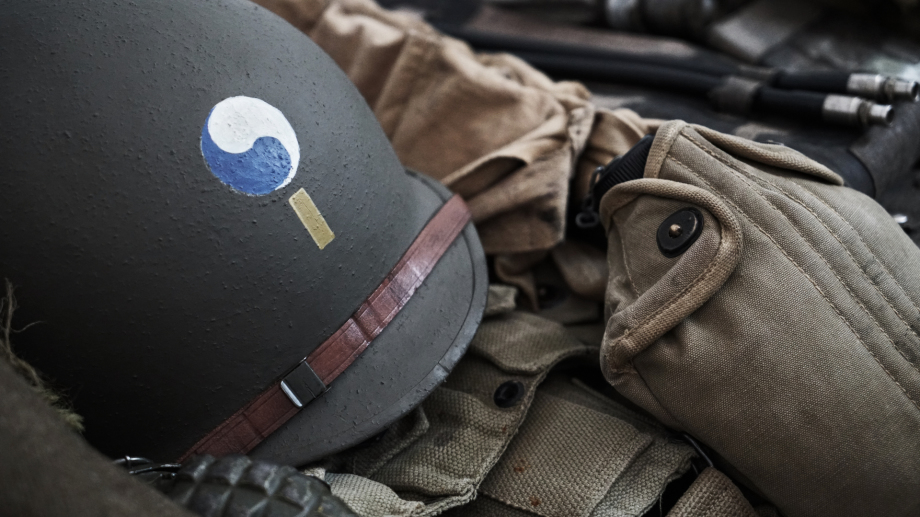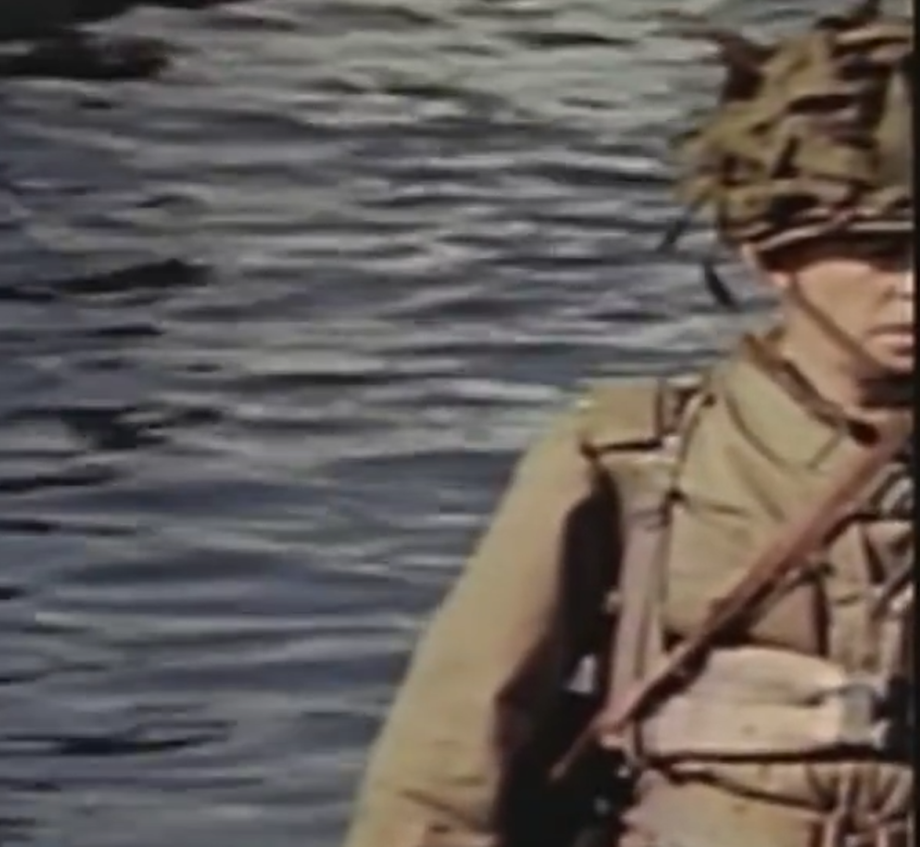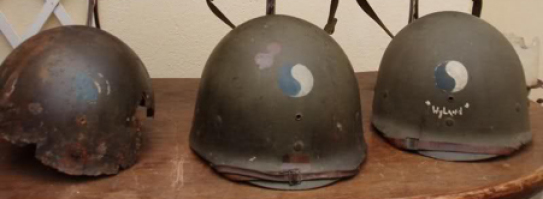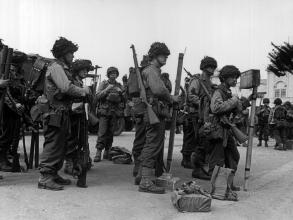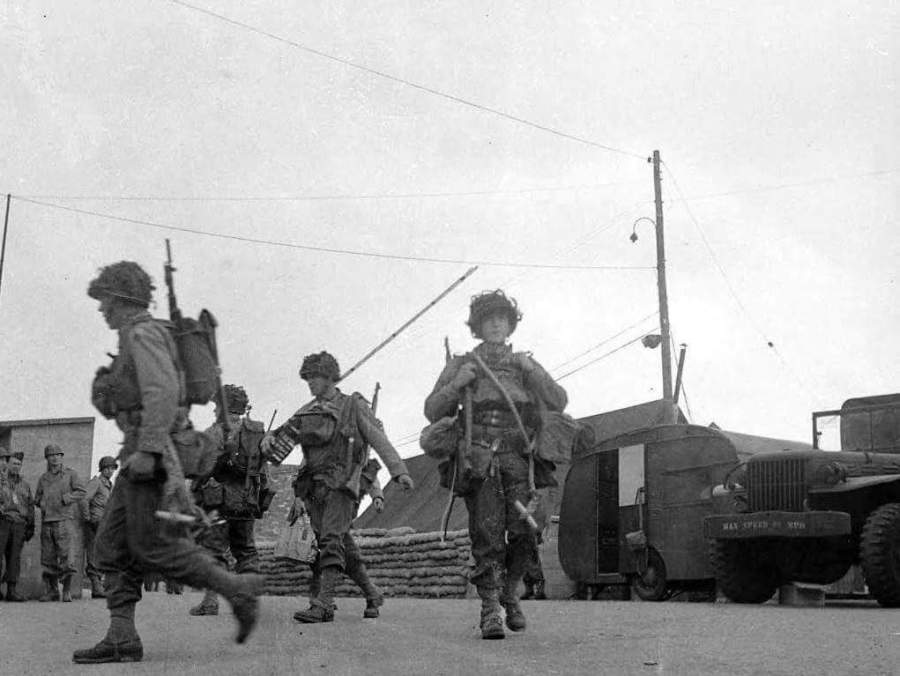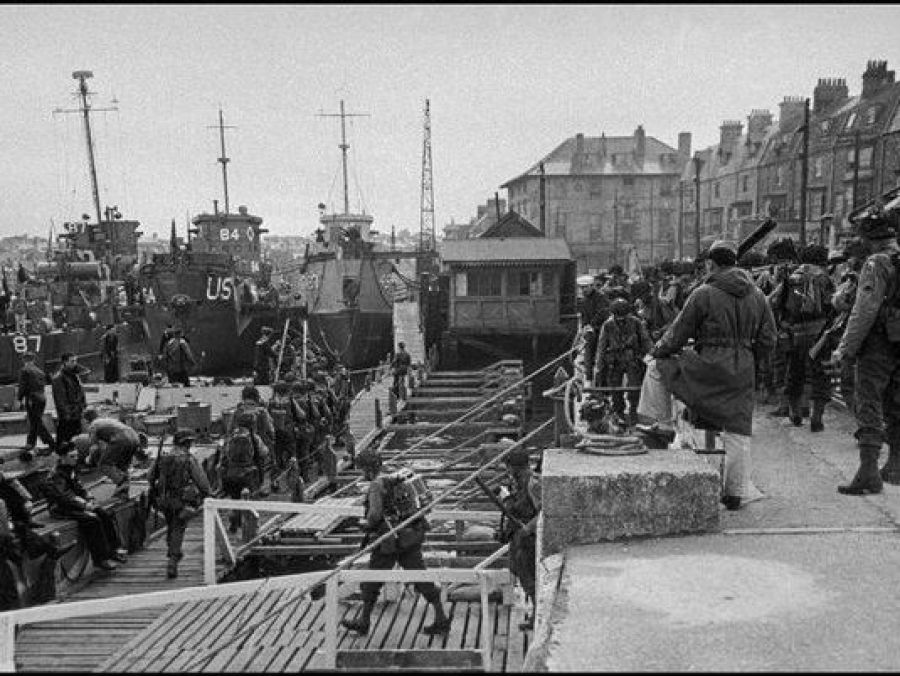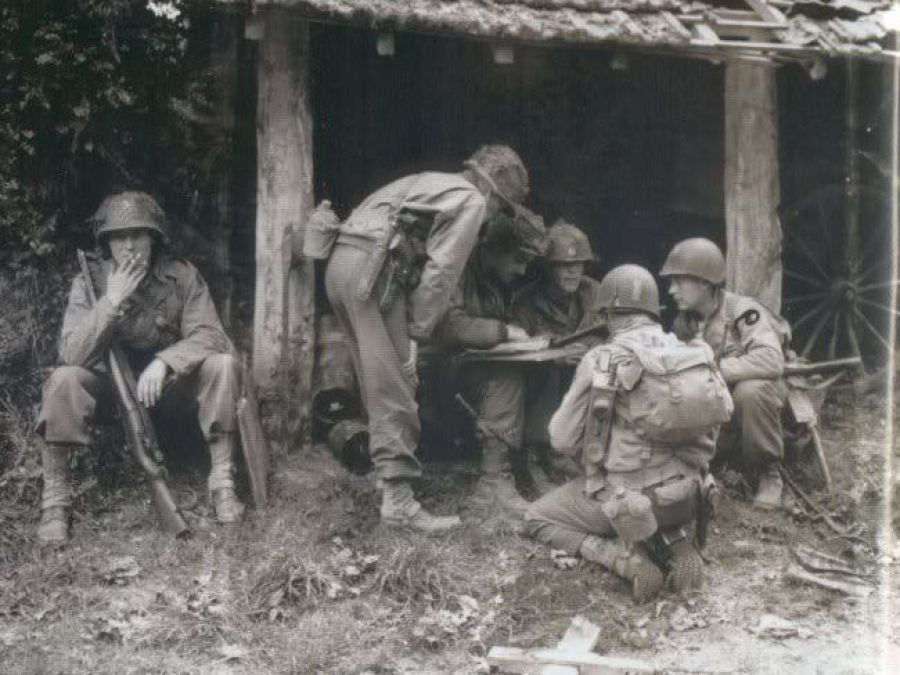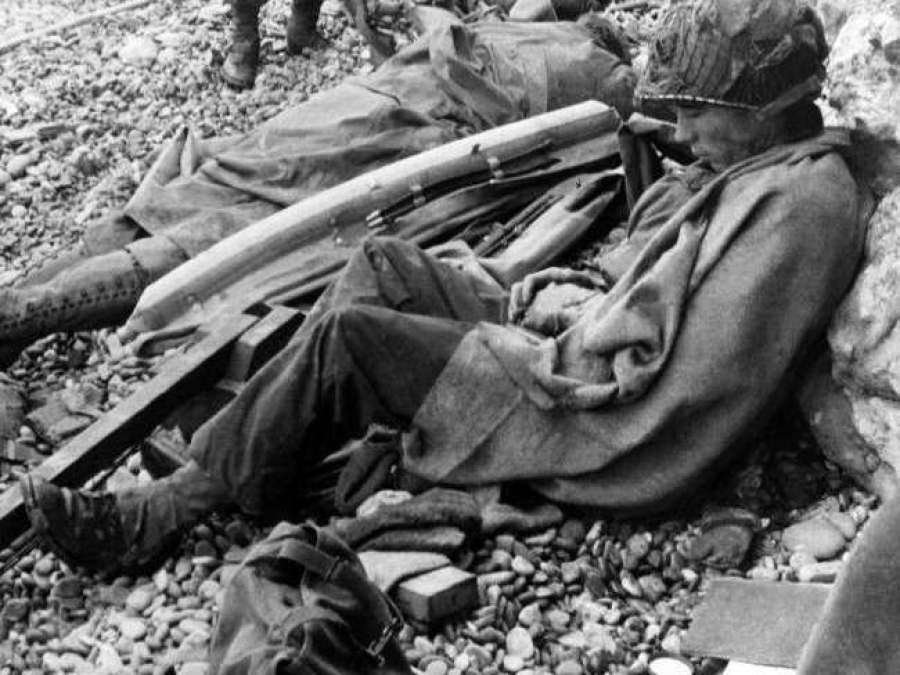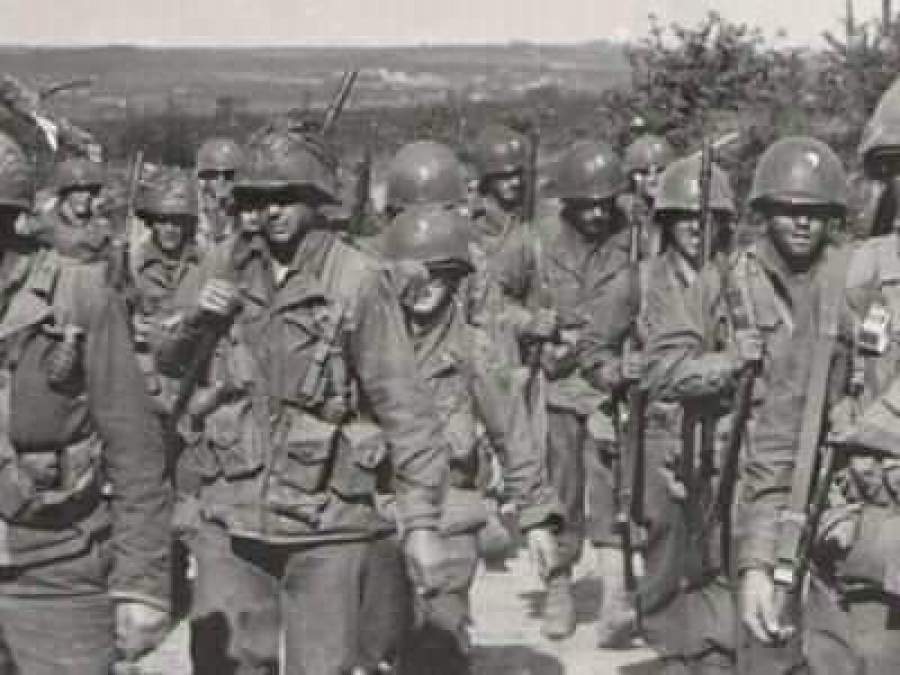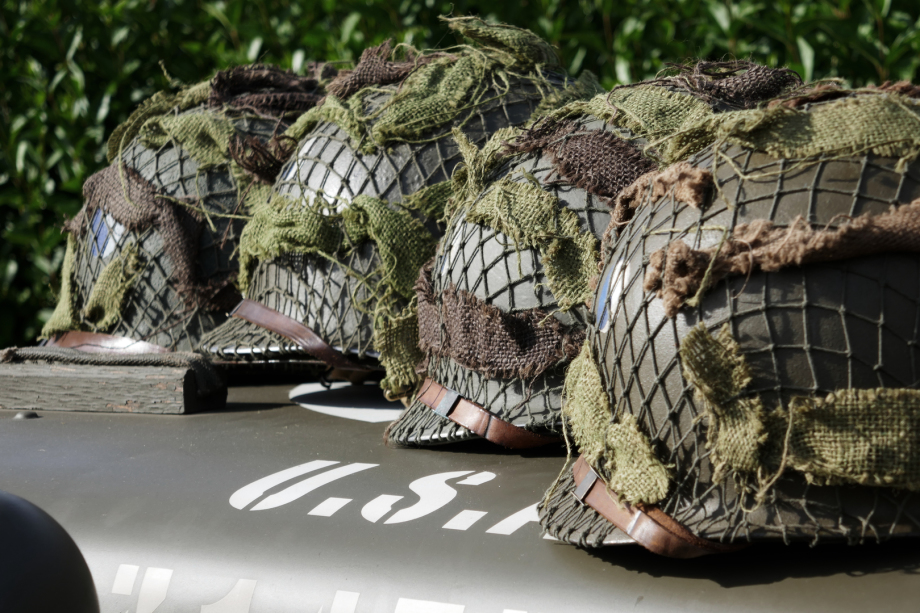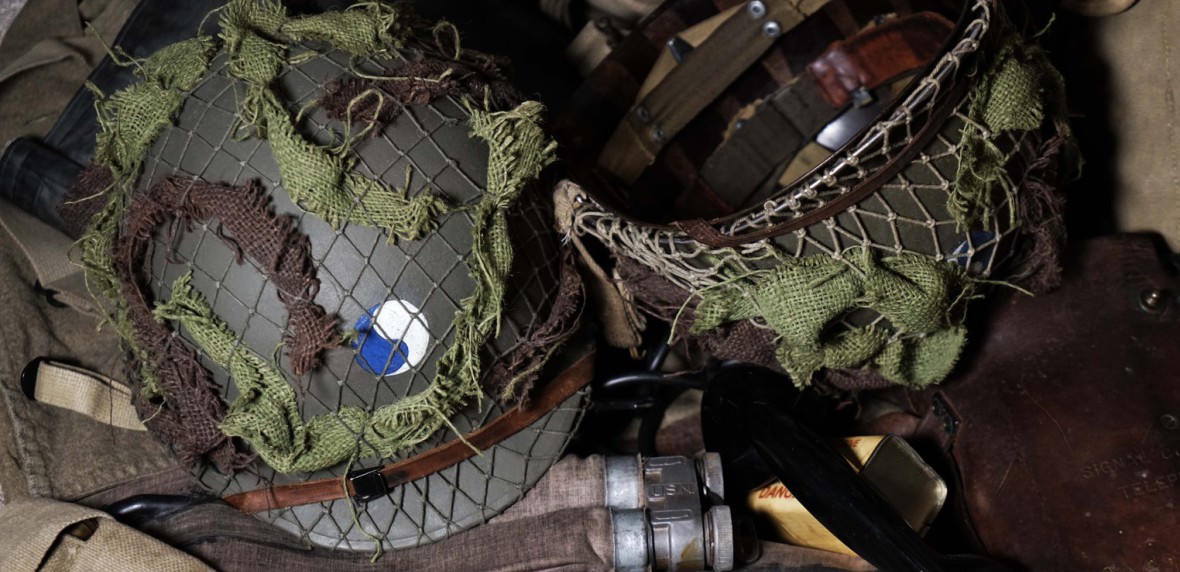
M1 Helmet
The M1 helmet and liner came in many variations throughout the war all looking very similar to the untrained eye. We are going to look at the helmets most commonly worn by the 29th Division from 1943 – 1945 with evidence and examples that back up our knowledge.
Through 1943 – 44 by far the most common M1 helmet and bale system used by the 29th was the front seam fixed bale. The Helmet would have the 29th emblem hand painted on the front varying in size from roughly 1.5” to 3”. The size variation looks to be unit dependant because in most photographs depicting more than 1 GI in the 29th we can see that all the helmets in the group have the same size emblem whether it’s the 1.5” or 3”. In C Company we adopt the 1.5” helmet emblem as we have found it to be most common amongst front line units.
The emblem itself is most commonly found hand painted with a brush and most likely a stencil was used to get the proportions correct however very un-symmetrical examples have been found. The position of the emblem should be on the front of the helmet slightly above mid-level. Emblems seen painted directly in the centre of the helmet closer to the leather chin strap have been found on 29th helmets, they are not incorrect.
A theory on these helmets is that replacement GI’s who had not read the 29th regulations would paint their emblems in this place. The regulation position of the emblem is above the mid-level. Spray painted emblems have also been found on artefacts during digs of 110th Field artillery positions, so they are not unauthentic either, however the use of a decal or sticker is not authentic.
Later in June and onwards veteran accounts tell us that the 29th emblem would act as a bullseye for German snipers in the bocage, many GI’s started to scratch off the emblem or paint over it in an attempt to camouflage them-selves. The helmet emblems always re-appear again most likely due to General Gerhardt’s high standards of dress, examples of 29th helmets found in Brest have the emblems painted on them long after the fight for St Lo. Plain helmets are considered correct for a front line unit like C Company especially if you have a complete original helmet with original paint.
For the invasion of France and later officer or NCO bars would have been painted on the rear of the shell, they are most commonly found hand painted using a brush. Variations on thickness and sizes are common as may NCO’s would have been promoted in the field and the paint applied during down time in areas behind the lines.
All 29th M1 Helmets should have the leather chin strap attached to the liner and be of a darker brown colour, reproduction chin straps are usually sold un-tanned and appear very bright and in some cases orange, this can be solved by applying brown or even black boot polish to the strap to take the reproduction edge off it.
The canvas chin strap was sewn directly to the bales of the M1 helmet and should not be riveted. Chin strap field repair examples have been found with rivets instead of stitching though these are rare. We see most 29th helmets having the sewn straps and would advise that they be the gold standard. Many different types of canvas, hooks and clips are found on original helmets and the design did not change dramatically throughout the however we do advise that these small details be as good as you can get them, simply filing down the edges of a post war chin strap clip can improve authenticity. For an added personal touch to your helmet you can write your laundry number or service number on it (We do not advise you do this to an original helmet)
Names and service numbers have been found painted on the inside of 29th helmet shells in white or even red paint, another completely optional touch you can add to your helmet if you so wish. (We do not advise you do this to an original helmet) When it comes to the seam, as mentioned before the most common for 1944 is the front seam M1 with fixed bales however swivel bales were produced in 1943 and therefore a front seam swivel bale helmet is also acceptable. Rear seam helmets were introduced in 1944 and photographs have been found of GI’s wearing them in Normandy post D-Day so they are not entirely incorrect but were very rare in comparison, to that end rear seam helmets are acceptable however for those of you looking for the best most authentic impression the front seam helmet should be on your list.
When it comes to helmet liners there are a few more hurdles to overcome as the variation is massive, prices of liners have increased dramatically in recent years and finding them slightly harder. The gold standard in helmet liners would be an original fibre liner with an American manufacture stamp on the inside however there are alternatives that are cheaper. The Belgian M1 liners made post war are identical from a distance if one is purchased of the brown colour, they will have a slightly lighter appearance and a painted stamp is usually found on the inside. These are fine as they are not obviously inauthentic however some Belgian liners are much more red than brown, these are still acceptable but we wouldn’t recommend spending the money on them. The helmet liner evolved for Vietnam and has a different strap array inside than the ww2 version, these are not authentic. The lowest standard of liner would be the post war plastic US or Belgian liners as these are noticeable from a distance if the helmet is left upside-down on display.
The Helmet liner should be of a matte OD green, Korean war helmet liners were painted in a semi-gloss OD paint. The 29th emblem was painted in a similar position to the shell’s emblem. Having an emblem painted on your liner is optional as it is extremely rare that we ever take them out of the shells however if you’re looking for that super platinum standard you can paint up your liner.
When wearing your helmet you should always have the chin strap fastened, this was a big deal for General Gerhardt as he would dish out punishments for any GI not abiding this rule even on the front lines. During the fighting in the bocage Gerhardt would frequently visit his troops, during his visits he would pick up soldiers for wearing beanie hats under helmets as well as chin straps and dirty jeeps. The front line GI’s would only slacken these standards when he was not about or when there battalion officers were out. During events we try to replicate these conditions and NCO’s and officers will pick you up for infractions of “Uncle Charlies” Rules.
From images we have of the 29th training at the assault training centre we know that they wore scrim in their helmet nets. On closer research it is my opinion that the 116th 1st wave all wore scrim in their helmets. We can see this in 3 Portland photographs of the 116th, they are mostly all wearing assault vests of the dark OD variety, carrying the equipment of an assault section and all have their chin straps fastened. From the pictures of the 3rd battalion 116th GI’s at the cliff East of Les Moulins Draw we can see that they all have scrim in their helmets as well. We also have images of 29ers fighting in St Lo wearing helmet scrim however St Lo was taken by the 115th 116th and 175th so we cannot say for sure. From barn finds and dug up helmets it has been established that the colour of scrim used in 29th helmets was the lighter British "apple green" and a dark brown. This scrim is found on a lot of original British helmets and it is likely that the 29th sourced their helmet scrim from the same supply.
